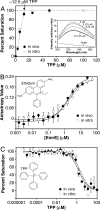X-ray structure of EmrE supports dual topology model
- PMID: 18024586
- PMCID: PMC2141897
- DOI: 10.1073/pnas.0709387104
X-ray structure of EmrE supports dual topology model
Abstract
EmrE, a multidrug transporter from Escherichia coli, functions as a homodimer of a small four-transmembrane protein. The membrane insertion topology of the two monomers is controversial. Although the EmrE protein was reported to have a unique orientation in the membrane, models based on electron microscopy and now defunct x-ray structures, as well as recent biochemical studies, posit an antiparallel dimer. We have now reanalyzed our x-ray data on EmrE. The corrected structures in complex with a transport substrate are highly similar to the electron microscopy structure. The first three transmembrane helices from each monomer surround the substrate binding chamber, whereas the fourth helices participate only in dimer formation. Selenomethionine markers clearly indicate an antiparallel orientation for the monomers, supporting a "dual topology" model.
Conflict of interest statement
The authors declare no conflict of interest.
Figures




References
-
- Chung YJ, Saier MH., Jr Curr Opin Drug Discovery Dev. 2001;4:237–245. - PubMed
-
- Schuldiner S, Granot D, Mordoch SS, Ninio S, Roten D, Soskine M, Tate CG, Yerushalmi H. News Physiol Sci. 2001;16:130–134. - PubMed
-
- Yerushalmi H, Lebendiker M, Schuldiner S. J Biol Chem. 1996;271:31044–31048. - PubMed
-
- Rotem D, Sal-man N, Schuldiner S. J Biol Chem. 2001;276:48243–48249. - PubMed
Publication types
MeSH terms
Substances
Associated data
- Actions
- Actions
- Actions
Grants and funding
LinkOut - more resources
Full Text Sources
Molecular Biology Databases

